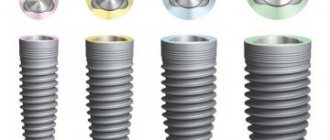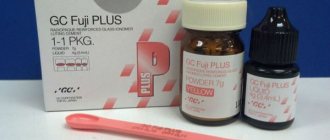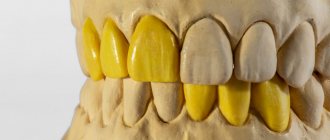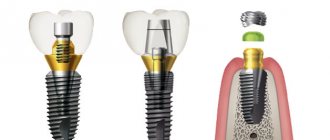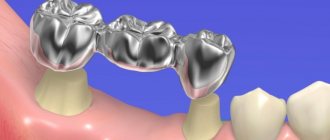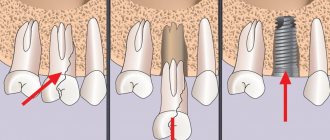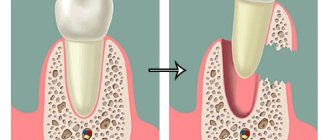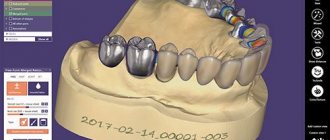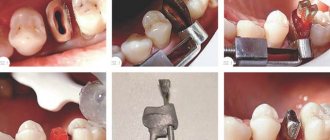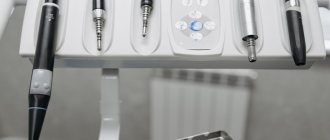2299
To restore the aesthetics and functionality of dental elements, many technologies have been developed, but many of them are not reliable enough or have a decent number of contraindications.
The unique Nobel Procera technology was developed taking into account all the disadvantages of alternative production.
The speed of installation, biocompatibility, and reliability of use of systems created using modern technology make it possible to restore chewing functions even in hopeless patients.
General overview
Nobel Procera technology is a metal-free restoration of the dentition. Modern methods for manufacturing prosthetic products make it possible to produce reliable and high-precision products, taking into account all the individual characteristics of the patient and in compliance with dental standards.
The technology makes it possible to produce fixed dentures in the complete absence of dentition according to the “All on Four” scheme with the introduction of an implant, or veneers, crowns, bridges for the restoration of one or several elements.
The main point of the technology is to use frames that are made using the method of milling block blanks under ultra-precise conditions of the manufacturing plant, using a three-dimensional computer modeling system.
This helps to achieve the best aesthetic and functional results in the manufacture of structures of any configuration.
Peculiarities
Prostheses using this technology are made without the use of metal. The main materials are zirconium dioxide and aluminum. Modern elements are very durable, their service life is more than 20 years. In this case, the thickness of the finished structure does not exceed 0.4 mm.
Such systems are resistant to loads and deformation; they are even fixed to implants.
Zirconium dioxide structures allow achieving high aesthetic results, do not damage the gingival margin and do not cause an allergic reaction.
Due to the high strength of the materials that are necessary to create a prosthesis, it is impossible to form them manually. For this purpose, a CAD/CAM system is used.
It includes three stages:
- oral cavity scanning;
- virtual creation of a prosthesis;
- fabrication of the structure.
The use of x-rays allows you to obtain images in one plane, while computer scanning creates an accurate model of the tooth, taking into account the upper and lower rows.
The results obtained are processed by a computer program, and a virtual prosthesis is created, which is used to reproduce an exact copy using robotic equipment.
How much do All-on-4 teeth cost?
The network of implantation clinics "EspaDent" has set a fixed price for all work using the All-on-4 technology. In Europe, the cost of a prosthesis reaches twenty thousand euros. We managed to create an affordable price thanks to our narrow specialization in this particular technique.
What's included in the price:
— consultation and initial examination of the patient, as well as CT scans before and after surgery; — taking impressions, sanitation of the oral cavity (hygienic work and removal of dental debris), installation of implants; — making a prosthesis in a dental laboratory; — installation of a prosthesis on implants; — improvement of the prosthesis after six months. The doctor will manufacture and install a fixed prosthesis with metal-ceramic crowns; — for out-of-towners, transfer and hotel accommodation. — All prostheses come with a lifetime guarantee.
Free initial examination. Sign up for a free consultation, and the doctor will diagnose your oral cavity and select the optimal treatment for you.
Selection of materials for the prosthesis. Based on the CT scan data, the doctor will receive a 3D model of the jaws, then select the appropriate sizes of implants and abutments. Next, the design and color of the dentition are coordinated in the dental laboratory.
How the operation goes. The operation is performed under a local procedure and takes no more than 2 hours. In the first stage, the remaining teeth are removed and four or six implants are installed. At the second stage, multi-units are attached to the implants, which will hold the prosthesis structure. The doctor takes individual impressions for the laboratory.
Installation of a prosthesis on dental implants. A composite denture is made within 4 hours after the operation. Next, the structure is fixed to the implants using screws. Immediately after this, the patient can speak, chew food and smile.
Improving the prosthesis. Six months after the operation, you can adjust the prosthesis made of composite material, or choose a more durable prosthesis made of zirconium or metal ceramics.
Production stages
The first stage is the process of tooth preparation by a doctor to install zirconium crowns. Next, impressions are made of both jaws, at the same stage the shade of the tooth enamel is determined to achieve the identity of the prosthesis.
Impressions are necessary to create an analogue that accurately copies all of the patient’s teeth. They are placed in a device that replicates the function of the temporomandibular joint. The device allows you to achieve optimal aesthetics and design comfort for the patient.
After this, the tooth in need of restoration is identified from the general model. His model is mounted in a Nobel Procera Scanner laser installation, where scanning and creation of a three-dimensional projection takes place.
The specialist makes a computer simulation of a zirconium dioxide cap, which will serve as a frame for the future crown. Digital data in electronic form is given to the manufacturing plant in Sweden for production.
The milling unit consists of a computer-controlled machine and two tips with replaceable cutters, which are directed mutually perpendicularly. Their movement polishes the product and removes excess material.
The finished frame is delivered back to the clinic, where specialists coat it with a specific ceramic mass to improve its aesthetic properties.
Methods of dental prosthetics without grinding and indications for their use.
Come here if you are interested in which crowns for implants are better.
At this address https://www.vash-dentist.ru/protezirovanie/nesemnyie-p/molochnyih.html we will tell you in what cases prosthetics of children's teeth is justified.
Advantages of Procera technology
The increasing popularity of the innovative prosthetic method is explained by its advantages:
- Lifetime warranty;
- Biocompatibility with soft tissues of the oral cavity;
- Durability and long service life of the prosthesis;
- High production speed;
- Hypoallergenic material;
- Attractive appearance;
- Suitable for any indication.
Contacting the Doctor Smile clinic guarantees you high-quality dental prosthetics. For this we have everything necessary: highly qualified orthopedic dentists and dental technicians, as well as high-tech equipment. We do not make mistakes when modeling and installing implants/crowns, which ensures our patients maintain the functionality of their teeth, a beautiful smile and no discomfort when chewing food. And this is especially important, because incorrectly installed implants and crowns can cause many diseases, for example, stomatitis, caries, mucositis and peri-implantitis.
Advantages
Nobel Procera technology has a number of advantages:
- Maximum adherence to the edge without damaging the gums, thanks to the use of computer modeling.
- Lightweight and durable metal-free system.
- Hypoallergenic, biocompatible, gum color fastness.
- Resistant to temperature and chemicals.
- Aesthetics of the product. It is almost impossible to distinguish a prosthesis from a natural tooth.
- Maximum preservation of dental tissue during grinding.
- Minimum load on the tooth.
Nobel Active Implant System
Implants of the Nobel Active are the most popular and popular, they are used in any, even the most difficult, clinical situations due to the following features:
- A high level of primary stabilization is provided by the expanding body of the implant and unique cutting blades located in the apical part. These features allow the use of Nobel Active implants in soft bone tissue, when performing simultaneous implantation and the need for immediate loading.
- The reverse-conical neck of the implant - thanks to it, the bone tissue in the neck area is preserved, the gum adheres well to the implant - this solution is vaguely reminiscent of the solution of Bicon and Megagen AnyRidge;
- Groovy grooves – a patented technology for applying grooves to the threads, thanks to which excellent stabilization properties of the implant are maintained;
- Cutting grooves with reverse function – located in the apical part of the implant, designed to adjust the position of the implant during installation;
- Implant 3.0 for installation in confined spaces - this Nobel Active implant model has a diameter of less than 3.5 mm, which allows implantation in narrow interdental spaces. Used to restore lateral and central incisors of the lower jaw, lateral incisors of the upper jaw.
Main differences from conventional crowns
The main difference between Nobel Procera technology and conventional crowns is the absence of metal, which allows you to achieve a 100% natural appearance of the dentition.
The dullness of a regular tooth is achieved due to the presence of enamel and dentin, the transparency of which is not the same. The light refraction in Nobel Procera systems is similar, only instead of natural dental tissue there are two other layers - ceramic enamel and a zirconium dioxide base.
The presence of metal in such structures reduces the reliability of the prosthesis and does not ensure a complete fit to the edge of the gum.
Contraindications
Contraindications to such prosthetics are pregnancy, acute chronic diseases of the body, bleeding disorders, undergoing radiation therapy, and drug use.
Relative contraindications include inflammation of the oral mucosa and the presence of dental problems, after which, after elimination, such prosthetics can be performed.
What are metal-plastic crowns, their advantages and disadvantages.
This publication contains all the most important things about CBW prosthetics.
Here https://www.vash-dentist.ru/protezirovanie/nesemnyie-p/koronki-np/tselnolityie.html we offer a detailed description of a one-piece crown.
Price
Pricing for prosthetics using Nobel Procera technology varies significantly. This depends on many factors such as:
- Prestige of the clinic.
- Geolocalization of the institution.
- Doctor's professionalism.
- The need for additional manipulations.
The cost of a temporary prosthesis is 6,000 rubles; if it is needed urgently, the price rises to 9,600 rubles, and installation of a permanent structure, taking into account a doctor’s appointment, making impressions and delivery from the factory, can reach 122,000 rubles.
If it is necessary to install one or more implants, the price for installing one unit is 12,000 rubles, and if it is produced by Nobel Biocare - 35,000 rubles.
The video provides additional material on the topic of the article.
About our clinic
All work is performed using modern professional equipment under conditions of absolute sterility. Surfaces are thoroughly sanitized after each patient. Operations are carried out at a high level, which corresponds to the best clinics in Europe.
- more than 1000 operations using All-on-4 technology monthly;
- more than 1,000 of our patients went home with a new smile in 2017;
- 50 specialists work on our staff;
- a network of clinics throughout Moscow;
- uniform cost of the procedure in all clinics;
- affordable cost of implantation.
Our specialists have been trained in the best dental implantation centers in Europe and Israel and are constantly improving their skills. By contacting the EspaDent dental implantation center, you will receive high-quality and affordable service at the highest level.
The article has been verified by:
If you liked this post, share it with your friends and subscribers.
Reviews
A healthy smile is the key to success, which is why thousands of people use Nobel Procera technology to restore it.
If you have experience using such structures, we ask you to leave your comments in which you can share your impressions and results of prosthetics.
If you find an error, please select a piece of text and press Ctrl+Enter.
Tags dental crowns fixed dentures
Did you like the article? stay tuned
Previous article
Correction of a gummy smile using gingivectomy
Next article
Let's be honest about the perfection of removable silicone dentures
